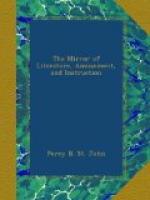[17] Rome, &c., vol. ii.
[18] Classical Tour, vol. i., p. 407.
Next is the grey pyramidal Tomb of Caius Cestius, in the fields called Prati del Popolo Romano, on the western side of the Aventine Hill. This ancient monument remains entire, an advantage which it owes partly to its form, well calculated to resist the action of the weather, and partly to its situation, as it is joined to the walls of the city, and forms part of the fortification. Its base is about 90 feet square, and it rises, according to Eustace, about 120 feet in height. It is formed, or at least encrusted, with large blocks of white marble; a door in the base opens into a gallery terminating in a small room, ornamented with paintings on the stucco, in regular compartments. In this chamber of the dead, once stood a sarcophagus that contained the remains of Cestius. “At the base of the pyramid stand two marble columns, which were found beneath the ground, and re-erected by some of the popes. One foot, which is all that remains of the colossal statue in bronze of Caius Cestius, that formerly stood before his tomb, is now in the Museum of the Capitol."[19]
[19] Rome, &c., vol. ii.—From
the monument we learn that he
was the contemporary of Caesar and Augustus,
but his name
does not appear in the annals, or the literature
of that
eventful and enlightened period; of his wealth,
and of
his pride, this magnificent tomb is a sufficient
record:
but of his merits or his virtues, no trace
remains. The
inscription only tells us he was one of the
seven
Epulones, whose office was to furnish and
to eat the
sacred banquets offered to Jupiter and the
Gods.




